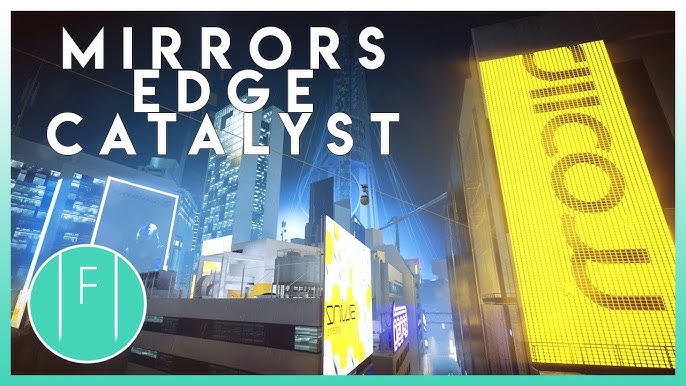In the landscape of modern video games, often saturated with gritty realism, explosive action, and complex systems, some titles stand out not for their bombast, but for their clarity of vision and aesthetic purity. Released in 2008, a time when the first-person genre was overwhelmingly dominated by military shooters, DICE’s Mirror’s Edge was a breathtaking departure. It traded bullets for momentum, cover-based shooting for rooftop parkour, and cluttered HUDs for a clean, minimalist world guided by color. The game’s enduring legacy is a testament to its profound and multi-faceted beauty—a beauty that extends far beyond its striking visuals into the very mechanics of its movement, the subtlety of its soundscape, and the elegance of its world design. It is an interactive experience where every element is meticulously crafted to serve a singular, powerful idea: the exhilarating freedom of motion.
This exploration delves into the layers of beauty that make Mirror’s Edge a timeless masterpiece. We will examine its revolutionary art direction, which turned a dystopian city into a stunning minimalist canvas. We will analyze the kinaesthetic grace of its gameplay, which successfully translated the physicality of parkour into a first-person perspective. Finally, we will appreciate the atmospheric sound design and environmental storytelling that breathe life into its sterile world, proving that beauty in game design is achieved when art and function become one.
A Canvas of Clean Lines and Bold Colors
The most immediately striking aspect of Mirror’s Edge is its unforgettable visual identity. In an era defined by the browns and grays of games like Gears of War and Call of Duty 4, DICE made the audacious choice to build a world of stark whites, clinical blues, and piercing primary colors. This wasn’t merely an aesthetic whim; it was a foundational design choice that informed every other part of the experience.
The Power of Minimalism
The unnamed city in Mirror’s Edge is a vision of a utopian dystopia. Its surfaces are clean, its architecture is modern and imposing, and its public spaces are devoid of the clutter and chaos of a real-world metropolis. This sterile environment creates a powerful sense of oppression and control, reflecting the totalitarian regime that governs its citizens. The beauty here is paradoxical; it’s the cold, intimidating beauty of absolute order. This minimalist approach serves a crucial gameplay purpose: it eliminates visual noise. By presenting the player with a clean canvas, the game can direct their attention with surgical precision, ensuring that the focus remains squarely on navigation and movement. The world itself becomes the user interface, a concept that was revolutionary at the time and remains elegant today.
Runner Vision: A Stroke of Genius
The most brilliant fusion of art and function in Mirror’s Edge is “Runner Vision.” Instead of relying on intrusive arrows, floating waypoints, or a distracting mini-map, the game guides the player through the environment using color. Objects that Faith can interact with to maintain her momentum—pipes, ramps, doors, and ledges—are highlighted in a vibrant, unmistakable red. This diegetic guide feels completely natural within the world. It suggests that Runners like Faith see the world differently, perceiving pathways and opportunities invisible to the city’s docile population.
Runner Vision is more than a simple waypoint system; it’s a language. A red pipe isn’t just a pipe; it’s a verb—a call to climb, to swing, to move. This transforms the act of navigation from a chore into a constant, engaging dialogue between the player and the environment.
This simple, color-coded system is beautiful in its efficiency. It respects the player’s intelligence, providing hints rather than explicit instructions, and preserves the immersion of the first-person perspective by keeping the screen almost entirely free of non-diegetic UI elements.

Architecture as a Character
The city in Mirror’s Edge is more than just a backdrop; it’s a character in its own right. Its personality is split. On the surface, it is pristine, orderly, and sterile—the face of the regime. But beneath this veneer, hidden in maintenance shafts, ventilation systems, and forgotten service corridors, lies another city. This is the city of the Runners, a complex web of pathways that represents freedom and rebellion. The level design brilliantly plays with this duality. Players will often find themselves bursting from a cramped, grimy air duct onto a breathtakingly open, sun-drenched rooftop. This contrast is central to the game’s beauty, highlighting the tension between confinement and escape, control and freedom. The architecture tells a story of a world that is beautiful on the surface but repressive at its core, and the true beauty is found in defying its intended structure.
More Than a Game: The Embodiment of Motion
While its art style is what first captures the eye, it is the gameplay of Mirror’s Edge that captures the soul. The game is a masterclass in kinaesthetics—the art of making the player *feel* movement. DICE set out to create the most immersive and believable first-person parkour system ever, and the beauty of their success lies in its commitment to physicality and flow.
Feeling the Flow
The core of Mirror’s Edge is the pursuit of “flow,” an uninterrupted chain of movement where running, jumping, sliding, and wall-running blend into a single, graceful sequence. The controls are designed to be intuitive, mapping actions like jumping and sliding to simple, accessible buttons. However, mastering the timing and rhythm required to maintain momentum is a deep and rewarding challenge. A perfect run in Mirror’s Edge feels less like playing a game and more like conducting a symphony of motion. The beauty is not in any single action, but in the seamless connection between them. When you successfully string together a vault over a railing into a slide under a pipe, followed by a wall-run and a leap across a chasm, the feeling is one of pure, unadulterated exhilaration.
A Truly First-Person Perspective
Many first-person games feel like you are controlling a floating camera with a gun attached. Mirror’s Edge makes you feel embodied. You constantly see Faith’s arms pumping as she runs, her hands reaching out to break a fall or hoist herself over a ledge, and her legs appearing as she slides or kicks open a door. The camera work is crucial to this sense of presence. It realistically sways and jostles with each step, dips low during a slide, and shakes violently upon a hard landing. This commitment to a physical presence was groundbreaking. It grounds the player in the world and raises the stakes of every jump. A miscalculation doesn’t just mean failure; it means a stomach-lurching plummet accompanied by the rush of wind and Faith’s panicked gasp. This visceral feedback is a key component of the game’s challenging and immersive beauty.
Combat as a Puzzle, Not a Priority
Another bold design choice was the de-emphasis on combat. While Faith can fight, it’s intentionally clumsy and disruptive. Stopping to engage enemies breaks your momentum and leaves you vulnerable. This reinforces the game’s core identity: Faith is a Runner, not a soldier. The most elegant and often most effective solution to an armed encounter is not to fight, but to evade. Using your parkour skills to outmaneuver, disarm, and bypass enemies turns these sections into high-stakes environmental puzzles. The beauty of this system is how it aligns with the game’s themes. Violence is the tool of the oppressive regime; movement is the tool of the free. By rewarding evasion over confrontation, the game makes a powerful statement through its mechanics alone.

The Auditory Landscape and Narrative Soul
The beauty of Mirror’s Edge is completed by its atmospheric and perfectly complementary audio design. From its iconic soundtrack to the subtle environmental cues, the sound works in harmony with the visuals and gameplay to create a cohesive and deeply immersive world.
An Unforgettable Score
The game’s soundtrack, composed by Swedish electronic artist Solar Fields, is a masterpiece of ambient music. During moments of quiet exploration, the score is ethereal and minimalist, filled with dreamy synth pads and gentle melodies that enhance the feeling of solitude and wonder as you traverse the city’s rooftops. When a chase begins, the music seamlessly transitions, introducing driving electronic beats and pulsing rhythms that heighten the tension and match the pace of the action. This dynamic score is perfectly attuned to the player’s experience. Capping it all is the beautiful and melancholic theme song, “Still Alive” by Lisa Miskovsky, which perfectly captures the game’s mix of hope, defiance, and underlying sadness.
Sound Design as a Gameplay Tool
Beyond the music, the sound design itself is rich with detail and purpose. The audio provides critical feedback that enhances situational awareness. The rhythmic thump of Faith’s footsteps changes depending on the surface she’s running on, from the soft patter on concrete to the sharp clank on metal. The rush of wind intensifies as you pick up speed or approach a long drop, viscerally communicating your velocity and the danger of the height. Most importantly, the crackle of enemy radios and their shouted commands are often your first warning of a nearby threat, allowing you to react and plan your route without needing a radar on screen. This is another example of the game’s commitment to diegetic information, using sound to make the world feel more real and the gameplay more intuitive.

A Timeless Masterpiece of Design
Years after its release, Mirror’s Edge remains a benchmark for art direction and first-person movement. Its influence can be seen in the fluid parkour systems of games like Dying Light and Titanfall, which built upon the foundation that DICE laid. Yet, the original still feels unique, largely because its vision was so singular and uncompromising.
The game has aged remarkably well, a benefit of its stylized, non-photorealistic art style. While games from that era that chased realism now look dated, the clean lines and bold colors of Mirror’s Edge are timeless. Its focus on a pure, refined mechanic also gives it immense replayability. The Time Trial mode, in particular, strips the experience down to its essence: the pursuit of the perfect, most efficient run. Here, the game’s beauty is distilled into its purest form—a dance of precision, timing, and flow.
Conclusion
The beauty of Mirror’s Edge is not a single attribute but a holistic achievement. It is the product of a development team that committed to a clear and powerful vision and ensured that every element—art, gameplay, sound, and world design—served that vision in perfect harmony. Its minimalist aesthetic is not just for show; it enhances gameplay clarity. Its first-person perspective is not just a viewpoint; it is a tool for embodying the physicality of movement. Its sound design is not just background noise; it is a vital source of information and atmosphere.
Mirror’s Edge dared to be different, offering a quiet, contemplative, and exhilarating experience in an industry chasing loudness and complexity. It is a testament to the idea that a game can be a piece of interactive art, where the beauty of the experience comes from the elegant fusion of form and function. It remains a shining example of how a unique aesthetic, when paired with groundbreaking mechanics, can create something truly timeless and profoundly beautiful.












